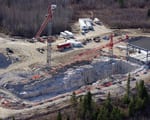Most supposed impact indicators at 29 sites are too old or too young to be remnants of an ancient comet that proponents claim sparked climate change at the end of the Ice Age, killed America’s earliest people and caused a mass animal extinction

Controversy over what sparked the Younger Dryas, a brief return to near glacial conditions at the end of the Ice Age, includes a theory that it was caused by a comet hitting the Earth.
As proof, proponents point to sediments containing deposits they believe could result only from a cosmic impact.
Now a new study disproves that theory, said archaeologist David Meltzer, Southern Methodist University, Dallas. Meltzer is lead author on the study and an expert in the Clovis culture, the peoples who lived in North America at the end of the Ice Age.
Meltzer’s research team found that nearly all sediment layers purported to be from the Ice Age at 29 sites in North America and on three other continents are actually either much younger or much older.
Scientists agree that the brief episode at the end of the Ice Age — officially known as the Younger Dryas for a flower that flourished at that time — sparked widespread cooling of the Earth 12,800 years ago and that this cool period lasted for 1,000 years. But theories about the cause of this abrupt climate change are numerous. They range from changes in ocean circulation patterns caused by glacial meltwater entering the ocean to the cosmic-impact theory.
The cosmic-impact theory is said to be supported by the presence of geological indicators that are extraterrestrial in origin. However a review of the dating of the sediments at the 29 sites reported to have such indicators proves the cosmic-impact theory false, said Meltzer.
Meltzer and his co-authors found that only three of 29 sites commonly referenced to support the cosmic-impact theory actually date to the window of time for the Ice Age.
The findings, “Chronological evidence fails to support claim of an isochronous widespread layer of cosmic impact indicators dated to 12,800 years ago,” were reported May 12, 2014, in the Proceedings of the National Academy of Sciences.
Co-authors were Vance T. Holliday and D. Shane Miller, both from the University of Arizona; and Michael D. Cannon, SWCA Environmental Consultants Inc., Salt Lake City, Utah.
“The supposed impact markers are undated or significantly older or younger than 12,800 years ago,” report the authors. “Either there were many more impacts than supposed, including one as recently as 5 centuries ago, or, far more likely, these are not extraterrestrial impact markers.”
Dating of purported Younger Dryas sites proves unreliable
The Younger Dryas Impact Hypothesis rests heavily on the claim that there is a Younger Dryas boundary layer at 29 sites in the Americas and elsewhere that contains deposits of supposed extraterrestrial origin that date to a 300-year span centered on 12,800 years ago.
The deposits include magnetic grains with iridium, magnetic microspherules, charcoal, soot, carbon spherules, glass-like carbon containing nanodiamonds, and fullerenes with extraterrestrial helium, all said to result from a comet or other cosmic event hitting the Earth.
Meltzer and his colleagues tested that hypothesis by investigating the existing stratigraphic and chronological data sets reported in the published scientific literature and accepted as proof by cosmic-impact proponents, to determine if these markers dated to the onset of the Younger Dryas.
They sorted the 29 sites by the availability of radiometric or numeric ages and then the type of age control, if available, and whether the age control is secure.
The researchers found that three sites lack absolute age control: at Chobot, Alberta, the three Clovis points found lack stratigraphic context, and the majority of other diagnostic artifacts are younger than Clovis by thousands of years; at Morley, Alberta, ridges are assumed without evidence to be chronologically correlated with Ice Age hills 2,600 kilometers away; and at Paw Paw Cove, Maryland, horizontal integrity of the Clovis artifacts found is compromised, according to that site’s principal archaeologist.
The remaining 26 sites have radiometric or other potential numeric ages, but only three date to the Younger Dryas boundary layer.
At eight of those sites, the ages are unrelated to the supposed Younger Dryas boundary layer, as for example at Gainey, Michigan, where extensive stratigraphic mixing of artifacts found at the site makes it impossible to know their position to the supposed Younger Dryas boundary layer. Where direct dating did occur, it’s sometime after the 16th century A.D.
At Wally’s Beach, Alberta, a radiocarbon age of 10,980 purportedly dates extraterrestrial impact markers from sediment in the skull of an extinct horse. In actuality, the date is from an extinct musk ox, and the fossil yielding the supposed impact markers was not dated, nor is there evidence to suggest that the fossils from Wally’s Beach are all of the same age or date to the Younger Dryas onset.
At nearly a dozen other sites, the authors report, the chronological results are neither reliable nor valid as a result of significant statistical flaws in the analysis, the omission of ages from the models, and the disregard of statistical uncertainty that accompanies all radiometric dates.
For example, Lake Cuitzeo, Mexico, Meltzer and his team used the data of previous researchers and applied a fifth-order polynomial regression, but it returned a different equation that put the cosmic-impact markers at a depth well above that which would mark the Younger Dryas onset.
The authors go on to point out that inferences about the ages of supposed Younger Dryas boundary layers are unsupported by replication in more cases than not.
In North America, the Ice Age was marked by the mass extinction of several dozen genera of large mammals, including mammoths, mastodons, American horses, Western camels, two types of deer, ancient bison, giant beaver, giant bears, sabre-toothed cats, giant bears, American cheetahs, and many other animals, as well as plants.
Meltzer is the Henderson-Morrison Professor of Prehistory in the SMU Department of Anthropology in Dedman College and a member of the National Academy of Sciences. — Margaret Allen
Follow SMUResearch.com on Twitter.
For more information, www.smuresearch.com.
SMU is a nationally ranked private university in Dallas founded 100 years ago. Today, SMU enrolls nearly 11,000 students who benefit from the academic opportunities and international reach of seven degree-granting schools. For more information see www.smu.edu.
SMU has an uplink facility located on campus for live TV, radio, or online interviews. To speak with an SMU expert or book an SMU guest in the studio, call SMU News & Communications at 214-768-7650.


 Real-time audio of corporal punishment shows kids misbehave within 10 minutes of spanking
Real-time audio of corporal punishment shows kids misbehave within 10 minutes of spanking Conventional vs. modern: Repertoire drives opera house identity, market share
Conventional vs. modern: Repertoire drives opera house identity, market share Women have made strides for equality in society, but gender gap still exists in art museum directorships
Women have made strides for equality in society, but gender gap still exists in art museum directorships Search for dark matter covers new ground with CDMS experiment in Minnesota
Search for dark matter covers new ground with CDMS experiment in Minnesota
 NOvA experiment glimpses neutrinos, one of nature’s most abundant, and elusive particles
NOvA experiment glimpses neutrinos, one of nature’s most abundant, and elusive particles SMU scientists to deploy seismic monitors in North Texas region near Azle, Texas
SMU scientists to deploy seismic monitors in North Texas region near Azle, Texas
 Parents less likely to spank after reading briefly about its links to problems in children
Parents less likely to spank after reading briefly about its links to problems in children Wall Street’s short sellers wrongly maligned — detected red flags ahead of US financial crisis
Wall Street’s short sellers wrongly maligned — detected red flags ahead of US financial crisis

 A director’s skills, experiences and workload drive their compensation, SMU study finds
A director’s skills, experiences and workload drive their compensation, SMU study finds Gut reaction of marital partners could foretell their marriage satisfaction
Gut reaction of marital partners could foretell their marriage satisfaction Fossil supervolcano discovered in Italy by SMU-led team is now key feature of new UNESCO Geopark
Fossil supervolcano discovered in Italy by SMU-led team is now key feature of new UNESCO Geopark